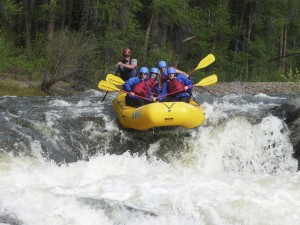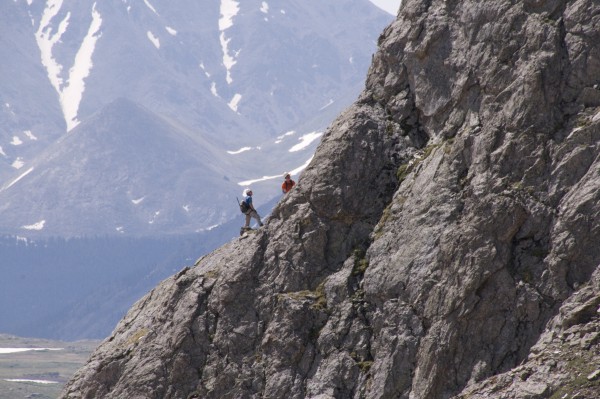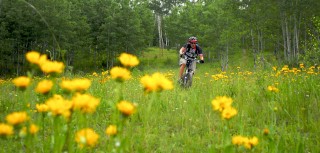The Rocky Mountain paradise appeals to adventurers of all kinds with a variety of outdoor escapades.
By Stephanie Nitsch
As the name implies, the Rocky Mountains are fortuitously so, making them a perfect playground for the adrenaline-happy thrill-seeker. Yet, those who enjoy Aspen’s mountain culture must also embrace its geological history and the relentless force of Mother Nature’s hand.
Tectonic plates under the Rockies have been active for about 70 million years, gradually uplifting the 1.7-billion-year-old rock to heights that top out at more than 14,000 feet. Glacial melting dating back 20,000 years has sculpted the Precambrian rock into curvaceous bowls, their cupped walls preserving snowpack in the winter and melting into pellucid alpine lakes and turbulent rivers in the summer. And with Aspen nestled in its own majestic valley, sheltered by some of Colorado’s most coveted “14ers” (peaks taller than 14,000 feet), it’s considered a slice of multisport paradise for a range of high-altitude adventurers.
“You get a new perspective in the mountains,” says 38-year-old Christy Mahon, an Aspen local and the first woman to climb up and then ski down all 54 of the 14ers in Colorado. Her reasons for moving to Aspen are also why she’s still here, more than a decade later. “The access is one of the most amazing things that I found living here,” she says. “You can get out before work, at lunch or after work and access the trails in the backcountry so quickly.”
Indeed, when residents and visitors step out the door, they’ll likely spot a trailhead within walking or biking distance. Trek just a short ways in and the marked trails give way to wilderness terrain, setting the stage for rugged adventures just beyond the modern conveniences of town.
High Aspirations
Notwithstanding the Rockies’ lofty stature, scaling a 14er—or any sizeable mountaintop—by foot is the easiest introduction to bagging a peak. “It’s within everyone’s reach [to climb a mountain],” Mahon says. “If you’re used to the altitude, in pretty good shape and looking for another adventure, it’s totally doable.”
The pursuit shouldn’t be taken lightly, however, when it comes to preparing for an ascent. While it’s possible to acclimate to the altitude, don’t expect to put mountaineering at the forefront of a visit to the Aspen area. Spend the first day strolling the streets or relaxing in town; venturing into the thin air of higher elevations too quickly can cause altitude sickness, a debilitating malady that can be warded off simply by taking it easy from the outset.
Beyond that, most preparations can be carried in a backpack until needed. “Pack enough water and snacks for the climb,” Mahon advises. “It’s always good to take a light down jacket or raincoat because it can be cold at the summit. At 14,000 feet, you’ll appreciate having it.” Sunscreen and a lightweight headlamp wouldn’t hurt either—just in case.
In addition to these supplies, certified guides are an invaluable resource as they can show hikers the ropes whether they’re approaching a first or fifth ascent. “No experience is necessary whatsoever,” says Fabrizio Zangrilli of Aspen Expeditions, which leads single-day and multiday adventures throughout the greater Aspen area. “[Hiring a guide is perfect] for people interested in doing something different or trying something new.” 
Perhaps the biggest perk of exploring with a guide involves gleaning the local insight that comes with years of experience. “A guide will take you off the beaten path and have a bunch of knowledge, whether it’s about birds, plants or the mountains,” Zangrilli says. “You get to go to less-visited places that offer the same amount of beauty.”
That’s not to say that adventure-seekers should opt out of climbing in the sought-after Independence Pass or circumnavigating the iconic Maroon Bells. Because wherever hikers end up, no matter how trodden the path, reaching the top is a reward worth celebrating. “When you stand on a summit and get to see the view, … you get that sense of immediate achievement,” Zangrilli says. “It gives you a sense of scale, an understanding of what the natural environment looks like, who you are as an individual and how you fit in your environment. It’s a tremendous sense of what’s possible.”
Rock Star
A technical and vertical approach to the mountains, rock climbing is the sister sport of mountaineering. The Gold Butte Climbing Area, a plot of soft sandstone crags pitched above the Roaring Fork River and the Rio Grande Trail, reopened late last year after being shuttered to the public for some 25 years. Its multipitch rise, perhaps modest by Colorado standards, is a foray into traditional and bolt climbing, welcoming novices and experts alike with big, forgiving holds and a few dozen routes from which to choose.
While Gold Butte offers a memorable experience, don’t miss the exhilarating rock climbing at Independence Pass, where visitors are likely to encounter mountain goats along the way. The definitive granite pass, stretching from Aspen to Twin Lakes, about a three-hour drive, is the highest paved mountain pass in Colorado—traversed by Colorado state Highway 82—and boasts a bounty of “hidden hamlets that are just off the road,” says Zangrilli, whose outfitting company also guides local rock climbing trips. With routes appealing to a wide range of abilities, the Independence Pass area is a climber’s haven for any level of cragsman.
On Two Wheels
If using hands and feet to scale sheer rock faces doesn’t present enough of a challenge, rest assured that the adrenaline-fueled alternatives are plentiful. Cross-country mountain biking is a popular cardio-focused workout, but downhill biking, involving burly full-suspension bikes and full-face helmets, is also on the rise in Aspen, thanks to a growing network of lift-served free-ride trails.
At Aspen Mountain, berms, jumps and wooden features are built into 15 miles of groomed trails that traverse the contours of the resort’s ski runs. Designed by Gravity Logic, the innovative firm behind the layout of the groundbreaking Whistler Mountain Bike Park in British Columbia, Aspen’s trails take a progression-based approach, enabling novices and experts to toe the same line while staying within their comfort zones—or pushing beyond them.
For skiers and snowboarders, downhill biking may feel like a natural segue: Riding a chairlift, carving through aspen groves and conquering rugged terrain are all part of the experience. Similarly, if riders are already comfortable pedaling on two wheels, adapting to the free-ride system is a relatively easy transition to make. Instructors at Aspen/Snowmass offer downhill bike clinics, literally geared to help participants find their rhythm and flow in the two-wheeled terrain park. By learning the ABCs of bike handling (active stance, breaking and cornering), students can master the resort’s meandering ribbons of free-ride trails, many of which come complete with smooth dirt jumps and ladder drops—as well as bypass options for riders who prefer to sidestep the risk.
Winging It
Suspended by a harness and carabiners and dangling some 11,000 feet in the sky, paragliding is every bit like that vivid flying dream you’ve always had. “You get to see the mountain ranges, valleys, rivers and everything that’s part of the Aspen Valley,” Alex Palmaz, owner of Aspen Paragliding, says of the aerial adventure. “You realize how free you are and how you’re a part of nature at that point because you’re flying. You feel the wind on your face and you open up your mind.”
 For most, the greatest challenge is simply opening that mental portal and overcoming the anxiety of leaving terra firma behind. “The hardest part is the initial 10 steps that it takes to run off the mountain,” Palmaz explains. “As soon as you’re in the air, the fear of falling goes away.”
For most, the greatest challenge is simply opening that mental portal and overcoming the anxiety of leaving terra firma behind. “The hardest part is the initial 10 steps that it takes to run off the mountain,” Palmaz explains. “As soon as you’re in the air, the fear of falling goes away.”
With the aid of a pilot, a tandem paraglide adventure lets adrenaline junkies experience the rush of soaring through the air without the necessity of preflight training—if they can run, they can fly. “The only experience you need is the passion for adventure,” Palmaz says, emphasizing that skill level and age have nothing to do with mastering the sport. For more than 20 years, he’s flown with both uninhibited 3-year-olds and daredevil 90-year-olds who have all successfully edged their way off the top of Aspen Mountain and drifted 3,000 vertical feet to a landing zone nestled in the valley’s floor.
Early morning launch times coincide with calmer conditions, which are ideal for younger children and hesitant aviators. As the day goes on, atmospheric changes create a playful arena for those with a wild side. Give him a nod and the pilot may even be inclined to catch a lift on a thermal, a solar-powered column of rising air that birds and paragliders alike use to gain altitude and coast a little longer. “It’s possible to catch a thermal and go up to 15,000 feet, extending the trip by 30 extra minutes,” Palmaz adds.
Uncharted Waters
The headwaters of the Roaring Fork River get their kinetic start near Independence Pass, picking up springtime runoff as tributaries like Hunter Creek and Castle Creek join up with the swelling confluence of rapids. Bounding its way through the middle of town, the fervent river boils over boulders and gains momentum before converging with the almighty Colorado River in Glenwood Springs, Colo.
Periodically, flocks of inner tubers will bobble along the river’s placid flat-water sections, its shaded nooks providing cool reprieves from the intense summer sun. But navigating the white-knuckle stretches of class IV and V rapids (on a scale of I to VI, with the latter being the most difficult and dangerous to navigate) requires the type of commitment better suited for a sturdier vessel, which may explain why kayakers and rafters have long preferred the Colorado and Roaring Fork rivers. Endless obstacles challenge even the most discerning paddlers, and the rivers’ lengthy spans are seemingly built for exciting multiday expeditions in the company of a guide and a few friends.
Recently, however, audacious sportsmen have taken to braving the waves in a different style: that of the stand-up paddleboarder so ubiquitous in coastal communities. Like a hybrid of Nordic skiing, surfing and kayaking, stand-up paddleboarding (SUP) on a river involves steering a modified longboard through class I and II rapids, all the while navigating the currents with only a paddle for balance. For the best results, pair a board rental—available from a regional outfitter like Aspen Kayak & SUP Academy—with a professional lesson to ensure an exciting river ride.
With so many outdoor activities calling their names, visitors no doubt will face the toughest challenges when deciding which ones to pursue. Fortunately, Aspen’s seasoned outfitters are on hand to assist explorers throughout their adventures—wherever they may lead.









